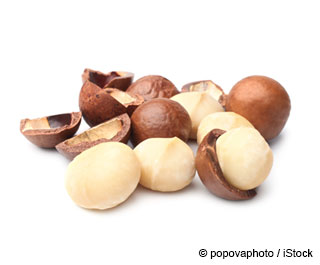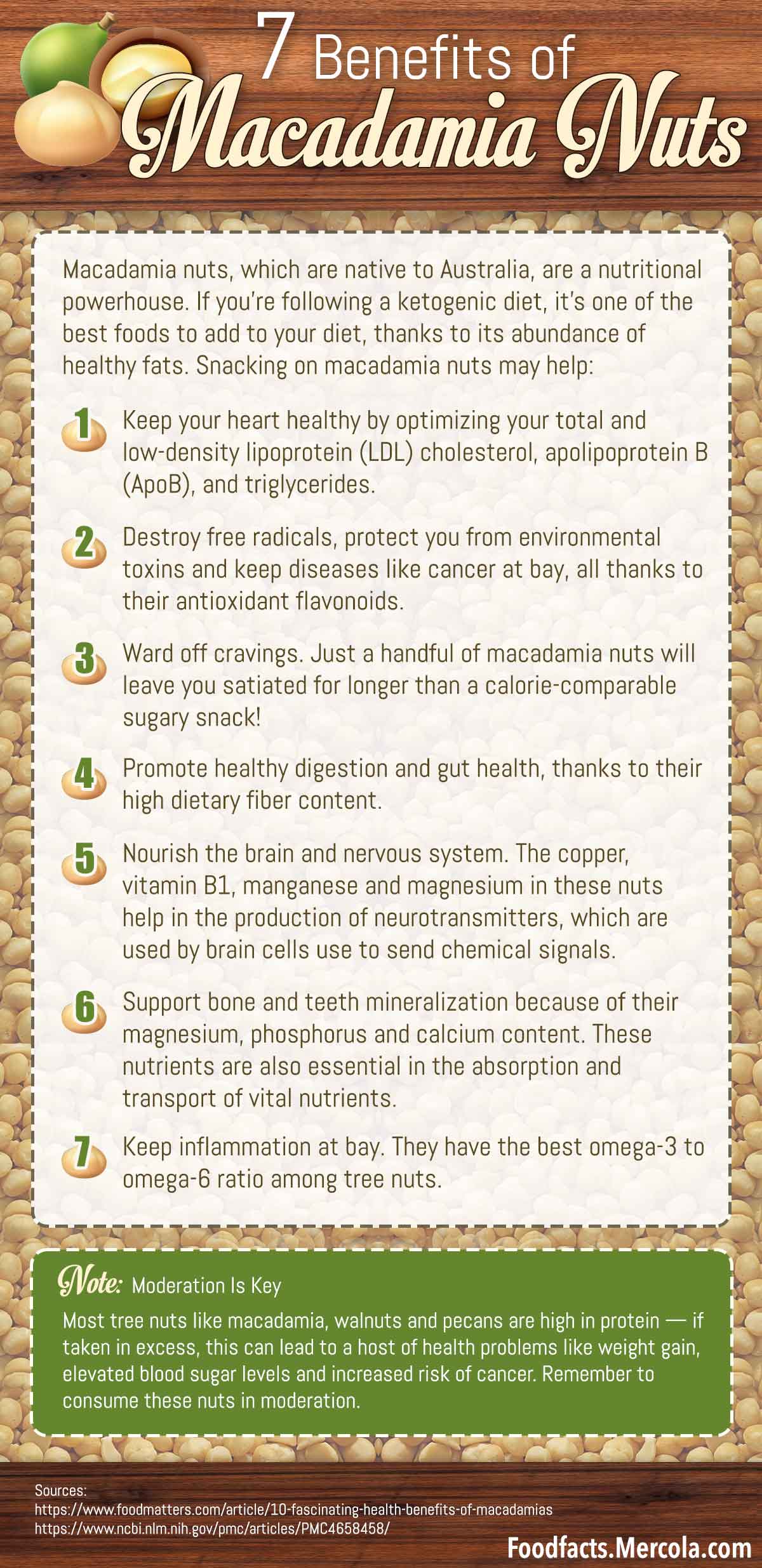Macadamia Academia
Botanical name: Macadamia integrifolia

When you think of macadamia nuts, Hawaii might be the first place that comes to mind, but this nut is actually native to Australia, which explains why the fruit is also known as the Australian or Queensland nut.1
From the Proteacea family of plants, evergreen macadamia trees can reach 40 feet in horizontal as well as vertical spread.2 Macadamias are some of the most sought-after nuts in the world, so they can be expensive.
This has driven up commercial production in other balmy areas like South Africa and Central America where the trees thrive if there’s sufficient water. Introduced in Hawaii in 1881 and soon afterward in California, Hawaii is now the world’s largest exporter.3 A 10-year-old macadamia tree might produce up to 50 pounds and increase indefinitely.4
Besides being a food source, the husks are composted for mulch or for fertilizer,5 and the oil is used in the cosmetic industry for skin and hair products. Macadamias are a tough nut to crack, as the saying goes. Containing at least 72 percent oil, they’re encased in a leathery, green husk that splits open as the nut matures.
Harvest comes when they fall from the tree, which is when the husk is removed and the nuts are dried.6 The shell can then be removed using a nutcracker. A handful of these nuts makes a crunchy snack, but they’re also great in pastries, fruit salads and garden salads.
Health Benefits of Macadamia Nuts
As a natural, whole food, macadamia nuts contain antioxidants, vitamins and minerals with significant health-boosting potential. They contain high amounts of vitamin B1 and magnesium, and just a 1-ounce serving nets 58 percent of what you need in manganese and 22 percent of the recommended daily value of thiamin.
Raw nuts contain a number of nutrients along with a healthy amount of monounsaturated fat. Macadamias, with their own unique nutritional profile, are relatively low in carbs and protein (containing 4 percent per 1-ounce serving), high in oleic acid and omega-9 monounsaturated fatty acid, the same fatty acid found in olive oil. In fact, of the 21 grams of fat found in macadamia nuts, only 3 grams are saturated fat.7
There’s sometimes a disconnect in the understanding of which foods contain good fats (HDL) and which have the bad kind (LDL). According to the American Heart Association:8
"LDL cholesterol is considered the ‘bad’ cholesterol because it contributes to plaque, a thick, hard deposit that can clog arteries and make them less flexible. This condition is known as atherosclerosis. If a (blood) clot forms and blocks a narrowed artery, heart attack or stroke can result. Another condition called peripheral artery disease can develop when plaque buildup narrows an artery supplying blood to the legs.
HDL cholesterol is considered ‘good’ cholesterol because it helps remove LDL cholesterol from the arteries. Experts believe HDL acts as a scavenger, carrying LDL cholesterol away from the arteries and back to the liver, where it is broken down and passed from the body.
One-fourth to one-third of blood cholesterol is carried by HDL. A healthy level of HDL cholesterol may also protect against heart attack and stroke, while low levels of HDL cholesterol have been shown to increase the risk of heart disease.”
When choosing fats that you should and should not eat, it’s important to note that it’s the type of fat that matters, not the amount. Not all saturated fatty acids are the same. If you eliminate them all, you’ll suffer serious health consequences. Healthy saturated fats are found in animal products like butter, cheese, whole milk and fatty meats. They’re also found in some tropical plants and vegetable oils such as coconut oil and olive oil.
You also have trans fats, which form when vegetable oil hardens, a process called hydrogenation. This can raise your LDL and lower HDL, which is not good for your health, especially your heart.9 Trans fats have a direct link to heart disease, Type 2 diabetes and even Alzheimer’s disease.10 In fact, Mayo Clinic names nuts as one of the five foods that can protect your heart health by lowering your cholesterol.11 Just make sure they’re not coated with sugar or salt and that you keep the serving size to around 1.5 ounces.
Peanuts excluded, raw nuts like macadamias have been proven to help trim waistlines rather than pack on pounds. A review of 31 clinical and university trials showed that when people included extra nuts or nuts in their diets or substituted for other foods, over five weeks, they lost rather than gained about 1.4 pounds and half an inch from their waists.12 Although that may seem to be a small amount, over time it makes a difference.
So, if you're watching your weight, a handful of nuts like macadamias or almonds is a much a better snack choice than a bran muffin. With about 60 percent monounsaturated fat oleic acid — the same amount as in olives — they provide the highest amount of healthy fat while being on the low end of the carb spectrum.

Macadamia Nuts Nutrition Facts
Serving Size: 3.5 ounces (100 grams), raw
| Calories |
718 |
|
| Calories from Fat |
634 |
|
| Total Fat |
76 g |
117% |
| Saturated Fat |
12 g |
60% |
| Trans Fat |
|
|
| Cholesterol |
0 mg |
0% |
| Sodium |
5 mg |
0% |
| Total Carbohydrates |
14 g |
5% |
| Dietary Fiber |
9 g |
34% |
| Sugar |
5 g |
|
| Protein |
8 g |
|
| Calcium 9% |
Iron |
20% |
*Percent Daily Values are based on a 2,000 calorie diet. Your daily values may be higher or lower depending on your calorie needs.
Studies Done on Macadamia Nuts
Clinical trials and studies demonstrated that the fatty acid profile of macadamia nuts beneficially affect serum lipids/lipoproteins, resulting in a lowered risk of cardiovascular disease.13 Additionally, a Journal of the American College of Nutrition study found that people who ate nuts benefitted in other ways, including:14
- Lower systolic blood pressure
- Less likelihood of having two of the risk factors for metabolic syndrome: high blood pressure and low HDL (good) cholesterol (for nut consumers)
- Less likelihood of having four risk factors for metabolic syndrome: abdominal obesity, high blood pressure, high fasting glucose and a lower prevalence of metabolic syndrome
Another reason why nuts are beneficial is that many of them, such as walnuts, hazelnuts, pecans, Brazil nuts, almonds and cashews, contain the amino acid l-arginine, which offers multiple vascular benefits to people with coronary heart disease. Nut consumption is also associated with a reduced incidence of diabetes in women, gallstones in both men and women, and beneficial effects on oxidative stress, inflammation and vascular reactivity.15
It’s also important to note that macadamia nuts are toxic for dogs and can cause weakness, vomiting, loss of coordination, tremors and hyperthermia.16
Healthy Macadamia Nut Recipe:
Raw Macadamia Fudge

|
Ingredients:
|
|
✓ 1 cup raw macadamia nuts or 1/2 cup macadamia nut butter
|
✓ 1 Tbsp. coconut oil
|
✓ 1 Tbsp. honey
|
✓ ½ tsp. vanilla extract
|
✓ ¼ tsp. sea salt
|
|
Optional:
|
|
✓ Unsweetened coconut
|
✓ Raisins or other dried fruit
|
✓ 1 tsp. cacao powder
|
✓ A few drops of lemon extract
|
|
✓ Roasted instead of raw macadamia nuts
|
✓ Substitute 2-3 tsp. of powdered stevia for the honey
|
✓ 1 large mango, peeled and pitted
|
|
Procedure:
- If processing your macadamias (rather than using prepared macadamia nut butter), place them into your processor and grind to a paste consistency.
- Add the remainder of the ingredients and continue processing until the mixture is creamy.
- Use a rubber spatula to transfer the mixture to a square, parchment paper-lined baking dish (or just a dinner plate) and smooth the top until flat.
- Place in the freezer for 30 to 60 minutes or until firm.
- Cut into bite-sized squares and serve immediately. Enjoy!
Note: the squares melt quickly, so place them into a baggie and return to the freezer between servings.
(From Detoxinista.com17)
Macadamia Nut Fun Facts
Macadamia trees were named by the director of Australia’s Royal Botanical Gardens, Baron Ferdinand von Mueller, to honor his friend and colleague, chemist Dr. John MacAdam. Ironically, MacAdam died onboard ship while en route to taste the nut that was named for him.18
Summary
One of the healthiest nuts, raw or otherwise, macadamia nuts originated in Australia, with the highest production coming from Hawaii. Today, they’re grown in a number of continents with moderate sun and plenty of water. Like many other nuts, they have a high “fat” content, but it’s the good fat — HDL, not LDL — that your body needs, to fight heart disease and lower your stroke risk.
Other healthy nutrients in macadamia nuts include the amino acid l-arginine, vitamin B1 and magnesium, and they’re an excellent source of manganese and thiamin while being low in carbohydrates. Try them roughly chopped in a green salad.